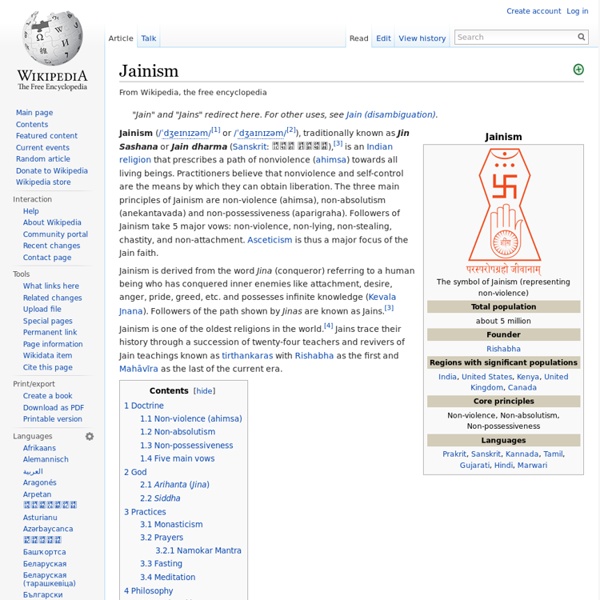Jina Parshvanatha
Idol of Pārśva Pārśva or Pārśvanātha (c. 877–777 BCE) was the twenty-third Tirthankara of Jainism.[1] He is the earliest Jain leader for whom there is reasonable evidence of having been a historical figure.[2][3][4] Life[edit] When he was a prince he saved a serpent that had been trapped in a log in an ascetic’s fire. Keśī is believed to have been born about 166 to 250 years after the death of Pārśva. Pārśva is the most popular object of Jain devotion. Notes[edit] Jump up ^ Fisher 1997, p. 115Jump up ^ Charpentier, Jarl (1922). References[edit] Deo, Shantaram Bhalchandra (1956), History of Jaina monachism from inscriptions and literature, Poona [Pune, India]: Deccan College Post-graduate and Research Institute, pp. 59–60 Fisher, Mary Pat (1997), Living Religions: An Encyclopedia of the World's Faiths, London: I.B.Tauris, ISBN 1-86064-148-2 Glasenapp, Helmuth Von (1999), Jainism, Motilal Banarsidass, ISBN 978-81-208-1376-2
Mahavira
Mahavira (540 BCE–468 BCE[1]), also known as Vardhamana, was the twenty-fourth and last tirthankara of Jainism. He was born into a royal family in what is now Bihar, India. At the time of his birth, the whole town marked prosperity in term of agriculture, health, wealth and wisdom. It is for this reason that he was named as Vardhman (Hindi : Vridhi) by his parents. Mahavira attained nirvana after his physical death at the age of 72. Early life[edit] Queen Trisala and the Newborn Mahavira According to Śvētāmbara traditions, the embryo of Mahavira was transferred from a Brahmin woman, Devananda, to a Kshatriya woman, Trisala. As a son of the king, Mahavira had all luxuries of life at his command. Jain traditions are not unanimous about his marital state. Ascetic life and awakening[edit] Kevala Jñāna of Mahavira At the age of 30, Mahavira abandoned all the comforts of royal life and left his home and family to live ascetic life for spiritual awakening. Teachings[edit] Mahavira's moksa.
Jain World
The Main schism of the Jain Church was the one between the Svetambaras and the Digambaras. The Svetambaras believe that even before this schism, there had been seven other schisms. These schisms had started when certain important leaders of the Church had disagreed with the views of the Main Church on some points of philosophy or ritual. These leaders had then taken away their followers and established what one might call separate sects. However, these schisms had little permanent effects, for the newly formed sects had either disappeared or had joined the main Church again on the death of their leaders. The seven schisms have been all described together in Avashyaka Niryukti, VIII, 56-100. The first of these schisms, as we have already seen, happened during the life of Mahavira himself. The second schism was started by Tissagutta in Rajagriha. The third schism was led by Asadha at Seyaviya, 214 years after the death of Mahavira. The Eighth Schism --- Digambaras and Svetambaras
Dal Sabzi for Aatman: Mahavira
Mahavira was born in Kundapura near Vaishali. He was born as a prince, in Bihar. The traditional Jaina date for Mahavira's birth is 599 BC. Lord Mahavir was the twenty-fourth and the last Tirthankara of the Jain religion. He was a reformer. He propagated Jainism, as taught by his predecessors. Mahavira was conceived in the womb of Devananda, who had fourteen prophetic dreams. To return to the life story of Mahavira, while the latter was in the womb of his mother, the wealth of the parent household increased. Mahavira married a princess named Yasoda, and they had a daughter, who was named Anoja. Severe austerities practiced by Mahavira: In the summer meditation under the rays of the sun or a walk through sun-baked fields. The power of endurance of Mahavira was tremendous. His message of nonviolence (Ahimsa), truth (Satya), non-stealing (Achaurya), celibacy (Brahma-charya), and non-possession (Aparigraha) is full of universal compassion. Jainism is self originated. Ravindra Kumar Jain
Lord Mahavira and His Philosophy
"Thou who hath large eyes and feet red and tender as is a lotus, who possesseth the ultimate knowledge as his intuitive vision, who redeemeth all from the bonds of attachment, temptations and hatred by his detached yet alluring words, O Ye, Lord Mahavira, I bow to thee in reverence and worship so as to be able to achieve the good and the virtuous," said the first century Jain monk Kundakundacharya, one of the earliest known teachers and annotators of the Jain dogma. The statement reveals three aspects of Lord Mahavira : his form; width of intuitive vision; and, power to redeem from the cycle of life and death. The Mutual Obligation to Protect Life (Parasparopagraha Jeevanam) Born in an era of social disparity, killing and violence inflicted in the name of rituals and sacrifice and for vengeance and hatred, Lord Mahavira emerged as a reformist, thinker, law-giver and guide. Previous Births of Mahavira Personal Life Of Lord Mahavira Birth And Early Days The Grammar Of Mahavira's Philosophy
Jainism, Jain Religion - colleges - temples - festival jainism



